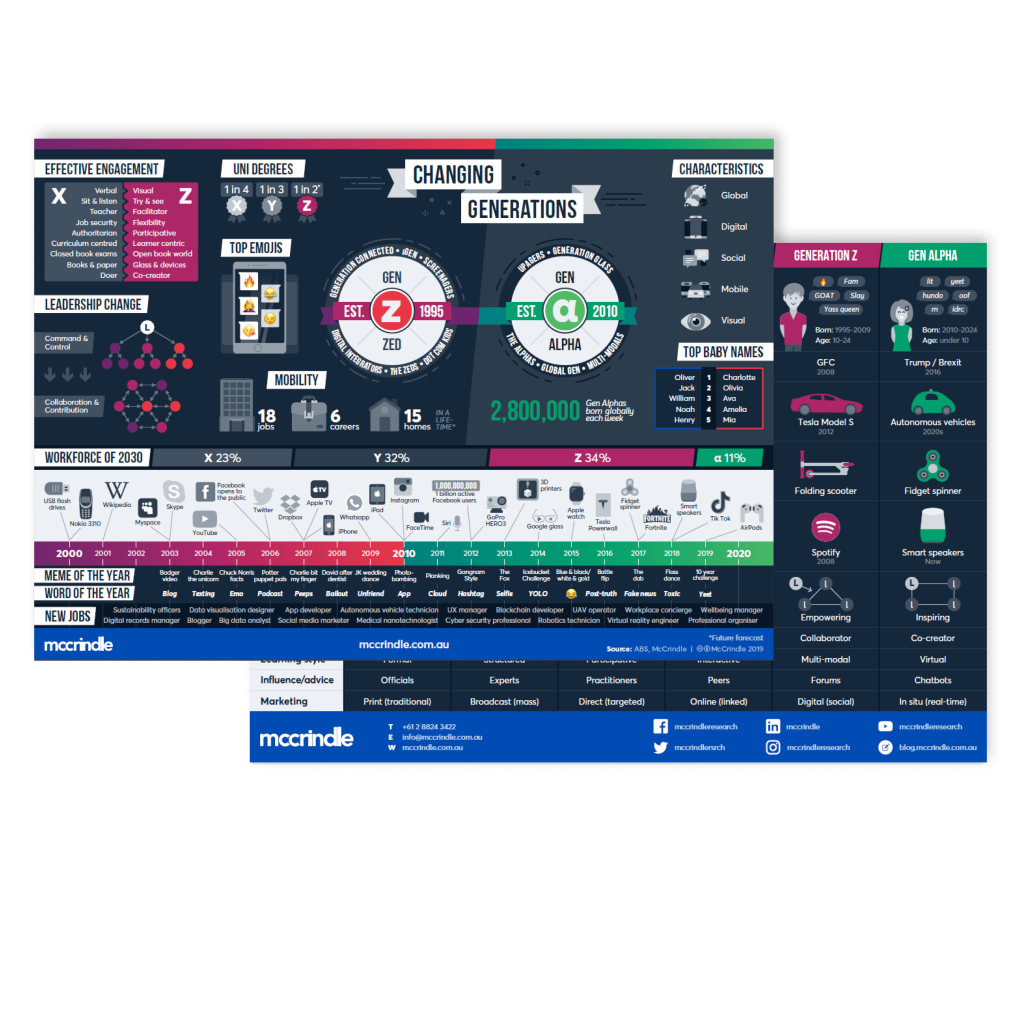By: McCrindle
In recent times the realities of an ageing population, an emerging generation of workers and their subsequent new attitude to work have dawned on many business leaders.
Dealing with these demographic changes and specifically how to not only attract and retain great workers but lead multigenerational teams has become one of the biggest issues facing employers today.
Since 2019, there are more Australians born since 1980 than before it. This means that Gen Y (born from 1980 to 1994), Gen Z (born from 1995 to 2009) and Gen Alpha (born since 2010) now comprise more than half the population. Additionally, Generations Y and Z now comprise the majority of the workforce, outnumbering Generation X and the Baby Boomers for the first time.
When it comes to keeping up with the trends and preparing for the future, the focus tends to be on technological shifts. Clearly the ever-changing technologies in business and in life are redefining our world. Yet interestingly, it is the social and demographic changes that have more profound implications on our future than even the massive technological ones.
The key to business success, therefore, is to understand these attitudinal shifts, social trends and the mindset of the everchanging customer and employee.
An overview of each generation
Baby Boomers
The Baby Boomers have lived through incredible change. They have adapted to, and in many cases created the change. They are therefore a very adaptive and flexible generation. This is seen in everything from their embrace of technology to their collaborative management style. This generation is likely to remain in leadership positions for longer than any previous generation. Their experience combined with their adaptivity will keep them relevant.
Gen X
Gen X is the perfect bridge generation. They understand and usually adopt the work ethic and focus of the Boomers. Gen X began their economic life when jobs were harder to get and keep. In the early 1990’s there was a recession and downsizing of the workforce. Very different to the near-full employment today. Gen X are close in age to the Gen Y’s and can connect somewhat with their culture, views, and workplace attitudes.
Gen Y
Also referred to as Millennials, they have sometimes been stereotyped as fickle, self-focussed and transient. The reality is that Gen Y have invested significantly in their education and are committed to growing their careers and are showing stability in their family-forming life stage. Managers who lead collaboratively, build an engaging work culture and offer growth opportunities will see loyalty and commitment from Gen Y.
Gen Z
Gen Z are almost exclusively the children of Generation X and are powerful players in today’s work culture. While the youngest of them are still finishing up their schooling, within a decade they will comprise a third of the workforce. They are looking to work with purpose, in organisations where workplace culture is prioritised and where the impact of their work is visible and celebrated.
Leading multi-generational teams
In and through their work, people are looking for opportunities to advance their careers, engage in Professional Development and training, and work with purpose. But transformational leadership is about more than just effectively leading employees. It is about developing leaders from different generations.
While each generation is unique and understanding generational differences helps to bridge the gaps that might exist between them, we also need to evaluate the leadership style leaders choose to lead with. Transformational leadership is about more than just effectively leading employees. It is about developing leaders from different generations.
Workplace leaders need to be collaborative. Workers today interact in far more engaging and participative ways than was previously the case. We have seen a move away from command and control, top-down leadership models towards more collaborative leadership styles. It is not only Gen Z who prefer and respond to collaborative leadership, but other generations too.
Our study of employed Australians found that three in ten workers experienced authoritarian (31%) and hierarchical (30%) styles of leadership when they began their career. Yet two in five workers (40%) prefer a collaborative style with the leader leading by example and from within the group, and the team collaborating to deliver outcomes. A further 38% prefer a coordinated leadership style, in a more collaborative environment with the leader giving some direction and the team making contributions.
Clearly authoritative and hierarchical leadership is out, and collaborative and coordinated leadership is in. These styles are more participative and engaging, where the leaders lead from within. Where they lead by example by inspiring and being part of the group. It is when leaders lead with authenticity and create space for diverse generations to collaborate that they are able to create environments for employees to thrive as well as the organisation itself.

Generation Z Infographic
From explaining the defining traits of each generation to shining a light on the emerging Gen Zs and Gen Alphas, this infographic provides a fascinating overview of the generations.
Article supplied with thanks to McCrindle.
About the Author: McCrindle are a team of researchers and communications specialists who discover insights, and tell the story of Australians – what we do, and who we are.
Feature image: Photo by Memento Media on Unsplash
